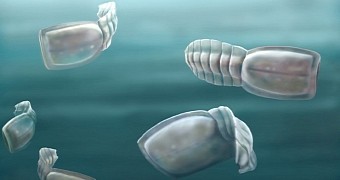In a recent paper in the journal BMC Evolutionary Biology, scientists with the University of Adelaide and the South Australian Museum argue that we humans are related to a group of downright bizarre creatures that populated the Earth eons ago.
Before reading any further, do take a few seconds to check out the image next to this article, which shows several such alien-like creatures going about their business in their aquatic habitat.
As one can easily notice, these ancient animals look nothing like we humans do. Still, the University of Adelaide and South Australian Museum maintain that they are our long-lost cousins.
The creatures' bio
As detailed in the journal BMC Evolutionary Biology, fossilized remains of these ancient creatures were first discovered back in 1911. Over the years, several others were found in countries such as Canada, China, Greenland and Australia.
However, it wasn't until 1997 that scientists placed these ancient animals in a group of their own, and decided to start referring to them as vetulicolians, Phys Org informs.
Having found vetulicolian fossils scattered all across the globe, researchers concluded that, long before humans emerged as a species, these aquatic animals were mind-bogglingly successful and populated pretty much every nook and cranny of our planet.
“Vetulicolians are further evidence that life was very rich in diversity during the Cambrian period,” Dr. Diego Garcia-Bellido said. “They were simple yet successful creatures, large in number and in distribution across the globe,” he added.
As mentioned, vetulicolians lived about 500 million years ago. They inhabited aquatic ecosystems and fed by filtering water and retaining the nutrients that came their way. Their bodies were shaped like the number 8, and evidence at hand indicates that they were blind.
How can we possibly be related to them?
What the University of Adelaide and South Australian Museum scientists mean when they say that we are related to these 500-million-year-old creatures is that vetulicolians belong to the same group that includes vertebrate animals such as humans.
Thus, the researchers say that, although these creatures had no say whatsoever in the emergence of humans as a species, they nonetheless are related to us. As they put it, vetulicolians are our long-lost and totally freaky cousins.
“They are close relatives of vertebrates – animals with backbones, such as ourselves. Vetulicolians have a long tail supported by a stiff rod. This rod resembles a notochord, which is the precursor of the backbone and is unique to vertebrates and their relatives.”
“Although not directly related to humans in the evolutionary line, we can confirm that these ancient water creatures are among our distant cousins,” study lead author Dr. Diego Garcia-Bellido explained in a statement.
The good news is that, since these creatures went extinct millions of years ago, there is no need to worry that they might show up at your doorstep out of the blue and ruin your winter holidays, as distant cousins sometimes do.

 14 DAY TRIAL //
14 DAY TRIAL //